Positioning and Use Cases of Grass
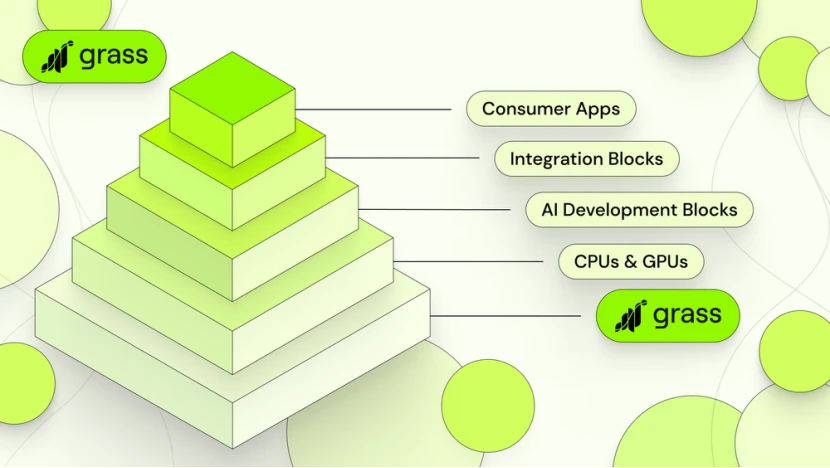
Grass is a project deployed on the Solana chain, combining AI, Depin, and Solana technology, positioned as the data layer for AI. It is a decentralized web scraping platform designed to help companies and non-profit organizations train artificial intelligence (AI) by utilizing unused internet bandwidth. It achieves web scraping through a browser extension application, leveraging individuals' unused internet bandwidth and rewarding users with Grass Points. By allowing users to share unused internet bandwidth resources, Grass aims to redefine the internet incentive structure, enabling users to benefit directly from the network and ensuring that the value of the internet is in the hands of the users. Currently, the network has over 2 million user-operated nodes that have scraped a vast amount of data for AI models.
Technical Architecture
The Grass Sovereign Data Rollup is a network specifically built on Solana, enabling the protocol to handle all transactions from data sources to processing, validation, and dataset construction. The network is built around Validators (issuing data collection instructions), Routers (managing web request distribution), and Grass Nodes (used by users to contribute their idle network resources). The specific architecture is as follows:
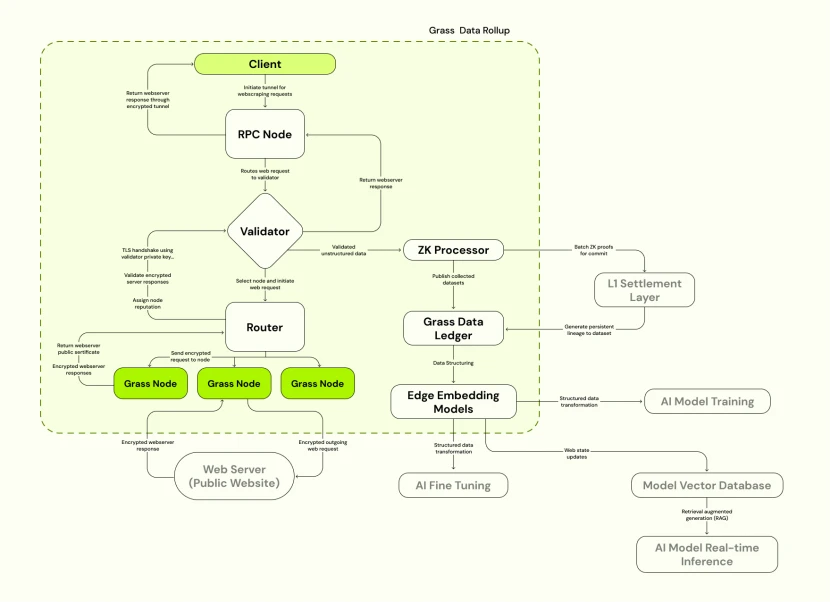 Validator: Receives, validates, and batches web transactions from Routers. It then generates ZK proofs to verify session data on-chain. On-chain proofs can be referenced in datasets to verify data sources and track their lineage throughout their lifecycle. The validator set will transition from an initially centralized framework of a single validator to a decentralized validator committee.
Validator: Receives, validates, and batches web transactions from Routers. It then generates ZK proofs to verify session data on-chain. On-chain proofs can be referenced in datasets to verify data sources and track their lineage throughout their lifecycle. The validator set will transition from an initially centralized framework of a single validator to a decentralized validator committee.
Router: Connects Grass Nodes to Validators. Routers maintain the traceability of the node network and relay bandwidth. Grass incentivizes its operation based on the total validated bandwidth provided through relaying. The Router is responsible for reporting the following metrics to Validators in the network: the size (in bytes) of each incoming and outgoing request; the latency of each node and the Validator; and the network status of each connected node.
Grass Node: Utilizes users' unused bandwidth and relayed traffic so that the network can scrape public web data (rather than users' personal data). Running a node is free, and node operators are rewarded based on the data relayed through their nodes.
ZK Processor: Validates the effectiveness of session data for all web requests in batches and submits proofs to the L1 blockchain. This operation permanently records every scraping action performed on the network. It also lays the foundation for a comprehensive understanding of the sources of AI training data.
Grass Data Ledger: This is the link between the scraped data and the L1 settlement layer. The ledger is an immutable data structure that hosts the complete dataset and links the data to its corresponding on-chain proofs, serving as a repository to ensure data provenance.
Edge Embedding Models: This is the process of converting unstructured web data into structured models. It includes all necessary preprocessing steps to ensure that the collected raw data is cleaned, normalized, and structured, meeting the format requirements of AI models.
Technical Features
In the architecture described above, the Grass network sits between the client and the web server. The client issues web requests, which are sent through Validators and ultimately routed through Grass Nodes. Regardless of which website the client requests, its server will respond to the web request, allowing its data to be scraped and sent back through the line. It will then be cleaned, processed, and prepared for training the next generation of AI models.
This process requires understanding two main additional features: the Grass Data Ledger and the ZK Processor.
The Grass Data Ledger is where all data is ultimately stored. It serves as a permanent ledger for every dataset scraped by Grass, embedding metadata that records its initial lineage from the moment of origin. The metadata proof for each dataset will be stored on Solana's settlement layer, and the settlement data itself is also provided through the ledger.
The purpose of the ZK Processor is to help record the sources of the datasets scraped on the Grass network. The process is as follows: when nodes on the network (i.e., users with the Grass extension installed) send web requests to a given website, it returns an encrypted response containing all the data requested by the node. This marks the moment of the dataset's birth, the origin moment that needs to be recorded, as well as the moment to log the metadata. It contains many fields, such as session keys, the URL of the scraped website, the target website's IP address, transaction timestamps, and of course, the data itself. Thanks to this necessary information and the clearly sourced datasets, AI models can receive accurate and faithful training.
The ZK Processor allows data that needs to be settled on-chain to remain unseen by Solana Validators. Furthermore, the volume of web requests to be executed on Grass in the future will exceed the throughput that L1 can handle. Grass will soon scale to the level of executing tens of millions of web requests per minute, and the metadata for each request will need to be settled on-chain. Without the ZK Processor first providing proofs and batching, it would be impossible to submit these transactions to L1. Therefore, Rollup is the only feasible method to achieve the planned goals.
In addition to recording the source websites of datasets, the metadata also indicates which node on the network routed it. This means that whenever a node scrapes the network, it can be rewarded for its contributions without revealing any of its identifying information. This allows Grass to proportionally reward nodes, with those scraping more and more valuable data receiving greater incentives. This mechanism will significantly enhance rewards in the world's most popular regions, ultimately encouraging people in those areas to register and increase network capacity. The larger the network scale, the greater the capacity Grass can scrape, and the larger the stored network data repository. More data means that Grass can provide more data for AI labs needing training data, thereby incentivizing the network to continue growing.
Operation of Grass Nodes and Security Mechanisms
Running Grass Nodes is free and serves as a gateway for the network to the internet. Node operators (i.e., application users) are rewarded for the traffic relayed through their nodes and receive network traffic based on their reputation scores and geographic demand.
Grass Nodes have two main uses: relaying traffic initiated by clients and instructed by Validators (i.e., web requests); and returning encrypted web server responses to designated Routers.
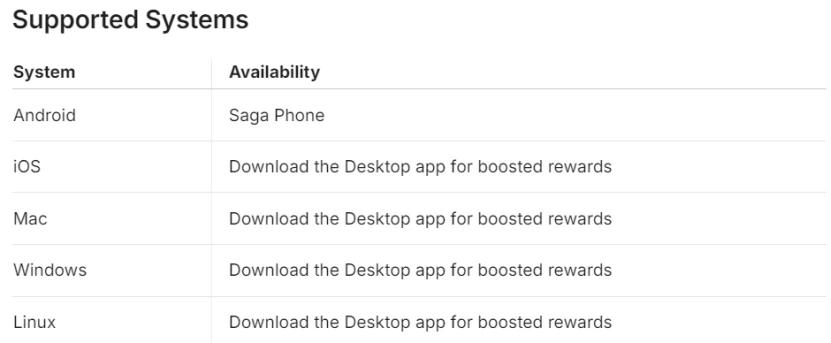
The systems supported by nodes are shown in the diagram above, and the process of running a node is straightforward: create an account, download the Grass desktop application, and connect to the network.
Once connected, the node automatically registers on the network. Operators are responsible for maintaining the network's uptime so that nodes can forward network requests to public network servers. Each request sent to Grass Nodes is an encrypted data packet. The packet only provides direction to the node at each packet's destination. Network requests are authenticated through digital signatures from all relevant parties. These signatures validate the legitimacy of the request and determine whether it should be forwarded to the target network server (i.e., public website). This encryption process prevents data tampering and ensures that Validators can accurately measure the reputation of each node.
Node reputation scoring primarily includes the following points:
Integrity: Evaluates whether the data is complete and whether the dataset contains all necessary data points required for the expected use case.
Consistency: Checks the consistency of data across different datasets or within the same dataset over time.
Timeliness: Measures whether the data is up-to-date when needed.
Availability: Assesses the availability of data from each node.
In terms of security mechanisms, the Grass network does not use user nodes (i.e., computers) or view any actions performed by users on their computers. It simply routes internet traffic through users' IP addresses, completely unrelated to users' activities. This means that Grass has zero access to users' personal data, and the scraped data is 100% sourced from public web data.
Additionally, Grass employs bandwidth encryption to ensure that all users are protected while sharing internet connections. Grass also collaborates with leading cybersecurity compliance auditing company AppEsteem, which monitors Grass's products 24/7 for vulnerabilities, leaks, backdoors, and malware to ensure user safety. AppEsteem certification is highly regarded in the cybersecurity industry, and obtaining this certification means that Grass's products are also whitelisted by top anti-malware applications, including Avast, Microsoft Defender, McAfee, AVG, and others.
Functions of Grass Token
Holders of Grass tokens can participate in the Grass network in several ways:
Trading and Buybacks: After decentralization, Grass will be used to support network scraping transactions, dataset purchases, and LCR (live context retrieval) usage.
Staking and Rewards: Staking Grass to Routers to facilitate network traffic and earning rewards for contributing to network security.
Network Governance: Participating in the development of the Grass network, including proposing and voting on network improvements, coordinating with which organizations to collaborate, and determining incentive mechanisms for all stakeholders.
According to statistics from Dune, the current annualized yield for staking Grass is around 45%, with approximately 33% of Grass tokens participating in staking, totaling over 26 million staked.
Router Staking and Earnings
Routers act as decentralized hubs, connecting all network nodes and managing the incoming and outgoing web requests of Validators. Router operations are incentivized, with rewards proportional to the amount staked to each Router. All traffic relayed through Routers is encrypted and measured to ensure security and performance.
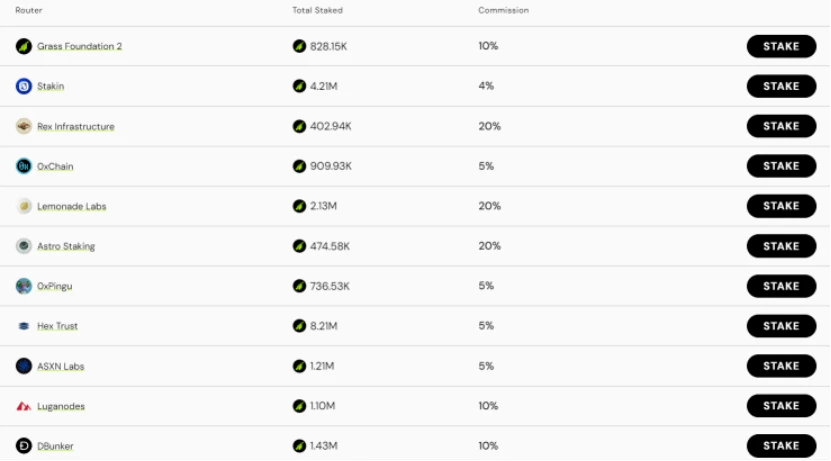
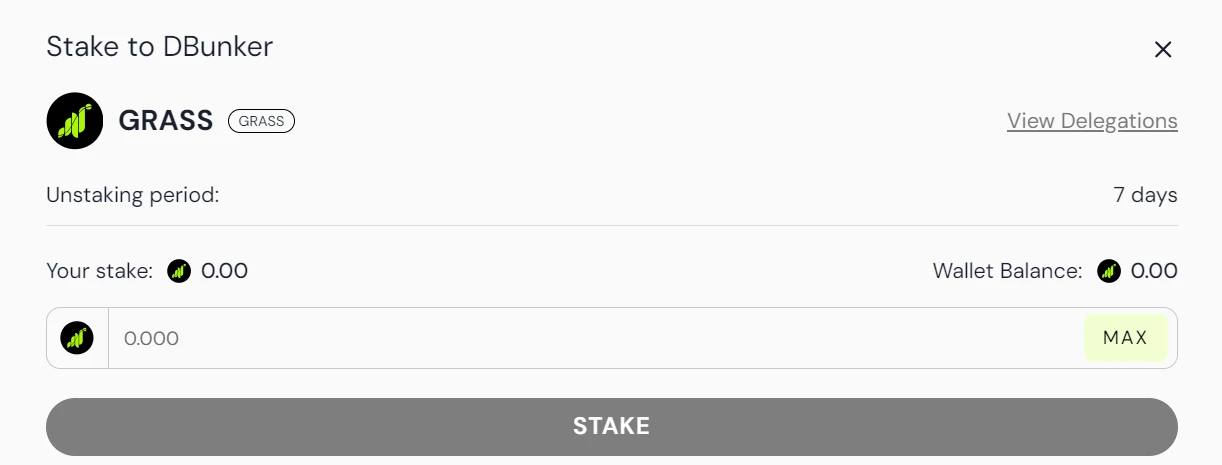
Currently, the staking amounts for each Router are shown in the image above. Users can stake Grass to Routers to earn rewards, with different commission rates for each Router.
Currently, the staking amount for DBunker is approximately 1.43 million Grass, with a minimum staking period of 7 days and a commission of 10%. (Data source: https://www.grassfoundation.io/stake/delegations) Users only need to click STAKE to connect their wallets, stake Grass, and earn Router staking rewards.
Summary
Grass is committed to building a fair and open decentralized data layer, aiming to address the ethical issues and data quality problems of current internet data extraction, opposing the phenomenon of data monopoly controlled by a few large companies. In terms of technical architecture and features, Grass introduces a metadata mechanism that records the sources of all datasets through the construction of data Rollup. The ZK proofs of these data are stored on the L1 settlement layer, while the metadata itself will ultimately be bound to its underlying datasets, as these datasets are stored on Grass's data ledger. Therefore, ZK proofs lay the foundation for enhancing transparency and providing proportional rewards to node providers based on their workload, which is also a crucial factor in incentivizing the expansion of the Grass network.
Grass focuses on the intersection of cryptocurrency and AI data, distinguishing itself as a raw decentralized source of AI data, unlike traditional participants in closed-source, centralized AI. As an important player in the web3 wave, Grass builds a fair and open data layer for AI companies and protocols through decentralized technology, with promising development prospects driven by market demand.
免责声明:本文章仅代表作者个人观点,不代表本平台的立场和观点。本文章仅供信息分享,不构成对任何人的任何投资建议。用户与作者之间的任何争议,与本平台无关。如网页中刊载的文章或图片涉及侵权,请提供相关的权利证明和身份证明发送邮件到support@aicoin.com,本平台相关工作人员将会进行核查。




